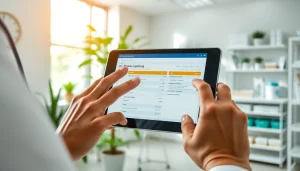Top E-Prescription Apps for Android to Enhance Medical Efficiency

Understanding E-Prescription Apps for Android
As the healthcare industry evolves, so do the tools designed to improve patient care and streamline medical processes. One of the most significant advancements in recent years is the rise of e-prescription apps, particularly those tailored for Android devices. These applications enable healthcare professionals to send prescriptions electronically, enhancing efficiency, accuracy, and access to medication for patients. By leveraging eprescription apps for android, practitioners can facilitate better healthcare outcomes and reduce the risks associated with traditional paper prescriptions.
What Are E-Prescription Apps?
E-prescription apps are digital tools that enable healthcare providers to write and send prescriptions electronically to pharmacies. Unlike traditional methods where prescriptions are handwritten or printed on paper, e-prescribing allows for faster, safer, and more accurate prescription management. These apps often integrate with electronic health records (EHR), allowing physicians to access patient histories, allergies, and medication lists directly within the app. This technology not only expedites the prescription process but also minimizes errors associated with misinterpretation of handwriting and missing information.
Key Benefits of Using E-Prescription Apps for Android
The adoption of e-prescription apps comes with a multitude of benefits:
- Improved Workflow Efficiency: E-prescribing eliminates the need to manually write prescriptions, reducing the time healthcare providers spend on this task.
- Enhanced Patient Safety: With the digital submission of prescriptions, errors due to illegible handwriting are eradicated, and alerts can be set for drug interactions or allergies.
- Streamlined Communication: Direct communication between prescribers and pharmacies ensures faster prescription refills and reduces waiting times for patients.
- Increased Adherence to Medication: By making it easier for patients to access necessary medications, e-prescription apps promote adherence to treatment plans, ultimately enhancing health outcomes.
- Access to Patient History: Real-time access to patient records allows for informed decision-making regarding prescriptions.
Common Features in E-Prescription Apps
Most e-prescription apps come standard with features designed to enhance functionality and user experience. Some of these include:
- Instant Prescription Transmission: The ability to send prescriptions directly to a pharmacy via the app.
- Medication History Tracking: Tools to track previous prescriptions, improving understanding of a patient’s medication regimen.
- Drug Interaction Alerts: Notifications for potential harmful drug interactions based on the patient’s current prescriptions.
- User-friendly Interface: An intuitive design that simplifies the prescribing process for healthcare providers.
- Mobile Access: Compatibility with mobile devices to allow for prescribing on-the-go.
How to Choose the Best E-Prescription App for Android
Choosing the right e-prescription app can be a daunting task, but understanding your specific needs can simplify this process. Here are several criteria to consider:
Assessing User Needs and Workflow
Before selecting an e-prescription app, it’s crucial to evaluate your practice’s workflow and specific user needs. Consider the following:
- Practice Size: Larger practices may require more robust features, like multi-user access and administrative controls.
- Specialization: Specialty providers should look for apps designed with features relevant to their specific practices.
- Existing Systems: Ensure the app is compatible with your existing EHR systems for smooth integration and data sharing.
Evaluating Security and Compliance
Security should be a top priority when implementing any software in healthcare. Ensure your chosen e-prescription app complies with regulations such as HIPAA, which governs the confidentiality of patient information:
- Data Encryption: Check that the app uses encryption to protect sensitive patient data during transmission and storage.
- Access Controls: The app should allow for user permissions to limit access to sensitive data only to authorized personnel.
- Audit Trails: Look for features that track user interaction and changes to patient prescriptions, providing transparency and accountability.
Comparing Usability and User Experience
An app’s usability can significantly impact its effectiveness within a practice. A user-friendly interface will enhance the efficiency of healthcare providers and reduce training time. Consider the following:
- Intuitive Design: Choose an app with clear navigation and straightforward functionalities.
- Customer Support: Ensure that the app provides reliable customer support and training materials for users.
- Feedback Mechanism: Select apps that allow users to submit feedback for continuous improvement.
Top Features to Look for in E-Prescription Apps for Android
When comparing e-prescription apps, ensure they offer the following essential features:
Integration with Electronic Health Records (EHR)
Integration with EHRs allows healthcare providers to view patient records seamlessly. This synchronization minimizes the time spent toggling between applications and enhances clinical decision-making. Look for apps that offer robust integration capabilities with popular EHR systems.
Prescription History and Patient Management Tools
A reliable e-prescription app should include features to manage patient medication histories effectively. This includes:
- Tracking previous prescriptions to avoid duplicate medications.
- Noting any adverse reactions from previous medications.
- Managing complex medication regimens for chronic illness patients.
Mobile Accessibility and User Interface
Access to e-prescription functions from mobile devices is essential for providers on the go. Ensure the app has:
- Responsive design for various screen sizes.
- Offline capabilities for areas with poor connectivity.
- User-friendly navigation to promote quick prescribing.
Best Practices for Implementing E-Prescription Apps for Android
Once you have selected an e-prescription app, proper implementation is key to success. Here are best practices to follow:
Training Staff on New Software
Organize comprehensive training sessions to ensure that all staff are proficient in using the new system. Training should include:
- Live demonstrations of the app’s features.
- Hands-on practice sessions to build confidence.
- Distribution of user guides and resource materials for reference.
Ensuring Patient Data Security
As discussed, maintaining data security is essential. In addition to choosing a secure app, consider:
- Regularly updating security protocols to counter new threats.
- Conducting periodic audits of app usage to ensure compliance with security policies.
- Implementing two-factor authentication for added account security.
Regularly Updating and Maintaining the Software
Staying current with software updates can enhance functionality and security. Establish a routine evaluation of the software for:
- Performance improvements or bugs.
- New features or tools that can improve workflow.
Measuring the Success of E-Prescription Apps for Android
To gauge the effectiveness of your e-prescription app, it’s essential to track certain metrics and gather feedback:
Key Performance Indicators to Track
Monitor specific KPIs to assess how well the app is performing, such as:
- Prescription accuracy rates to measure reduction of errors.
- Time taken to process prescriptions before and after implementation.
- Patient adherence rates to prescribed medications.
Feedback and Continuous Improvement
Gathering feedback from users can provide insights into the app’s performance and areas for improvement. Consider implementing:
- Regular surveys to collect user experiences and suggestions.
- A suggestion box or forum for ongoing input from healthcare providers.
Case Studies of Successful Implementations
Researching successful case studies of similar practices can offer valuable insights. Look for examples that demonstrate best practices, challenges faced, and the solutions implemented to maximize the effectiveness of e-prescription apps. This research can also provide benchmarks for measuring your own practice’s outcomes.






